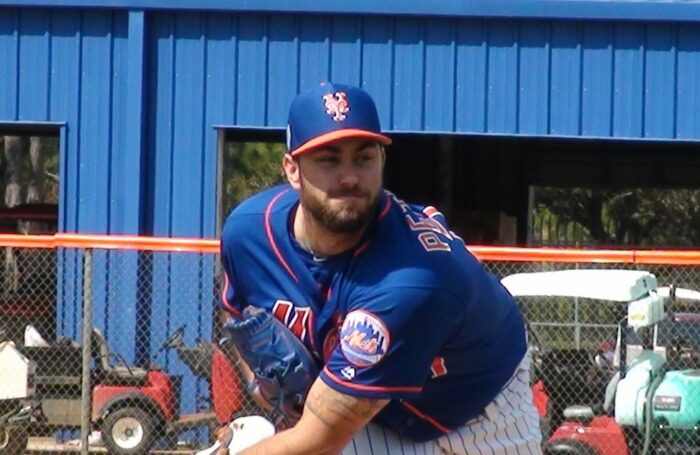
David Peterson, Photo By Ernest Dove
No. 7 David Peterson LHP
B/T: L/L Age: 24 (9/3/1995)
Height: 6’6’’ Weight: 240 lbs
Acquired: Drafted in 1st round (20th overall) of 2017 Draft from University of Oregon
ETA: 2020 Previous Rank: 6
2019 Stats (Double-A): 4.19 ERA, 3.19 FIP, 2.91 xFIP, 116.0 IP, 122:37 K:BB, 1.345 WHIP
Since being selected as the Mets’ first-round draft pick in 2017, Peterson has made steady progress through the Mets farm system and has emerged as a solid prospect who may contribute to the MLB team in the very near future.
Despite being known as an amateur prospect since he was in high school (drafted by the Red Sox in 2014, but didn’t sign), Peterson significantly boosted himself into the upper tier of draft-eligible pitching prospects in 2017 with an outstanding final season at Oregon.
Peterson would finish that season with a 2.51 ERA and 9.33 K:BB ratio and looked like as sure a bet as any pitcher in the draft to make the majors quickly as a mid-to-back of the rotation starter. For this reason, the Mets made him their first-round pick and sent him to Brooklyn, although he would only pitch 1.2 innings there before being shut down with an ingrown toenail.
Following that usual injury, Peterson has been mostly healthy over the last two seasons, although his performance has been somewhat mixed. The Mets were conservative at first with Peterson, sending him to Columbia to begin the 2018 season While there, he dominated for nine starts, forcing a quick promotion to St. Lucie. In St. Lucie, he saw his first bumps in the road to the majors, with all of his peripheral stats heading in the wrong directions, resulting in an ERA heading into August of 7.03. From this point, however, he would pitch better than he ever had, producing a 0.62 ERA and 32:5 K:BB ratio over his last five starts (29.0 innings pitched). The increase in strikeouts is notable, as, even when he was dominating in Columbia, Peterson relied more on getting groundballs and weak contact than maintaining an elite strikeout rate (8.65 K/9 in Columbia).
Somewhat surprisingly, as Double-A is when pitchers with non-elite stuff really start to struggle to miss bats, Peterson struck out more batters and produced more swings and misses than he ever had before. Among all Eastern League pitchers with at least 80 innings pitched in 2019, Peterson’s 9.47 K/9 ranked fifth and his 13.7% swinging strike percentage ranked second.
Combined with his good command and ability to limit home runs, Peterson produced the eighth-best FIP in the league (3.19) and third-best xFIP (2.91). However, despite the extremely promising underlying numbers, many overlooked or were even disappointed, by Peterson’s season due to a lackluster 4.19 ERA driven by an unsustainably high .340 BABIP.
While one could argue that Peterson may be prone to having a higher BABIP as a groundball pitcher (groundballs in play are more likely to be hits than flyballs in play), it seems more likely that a combination of poor infield defense, lower quality minor league infields, and some degree of bad luck are most to blame for this. Following the 2019 regular season, Peterson was solid (3.46 ERA, 9.0 K/9) over 13 innings pitched in the Arizona Fall League.
Heading into 2020, in many ways, Peterson looks like virtually the same pitcher he was when he was drafted. In college, he was known for a low-90s fastball that was hard to barrel up and that produced a ton of ground balls.
There was some hope that he could get a bit more fastball velocity out of his large frame as he refined his mechanics, but, with Binghamton, he was still sitting in the 89-93 MPH range. However, it is interesting to note that Peterson has arrived at spring training in significantly better shape and was sitting in the 93-94 MPH range in his first spring appearance. Time will tell if this boost in velocity was just an aberration or a sign of genuine improvement.
The spin rate on Peterson’s fastball averages 2150 RPM, which is quite low, as the average fastball spin rate is around 2250 RPM. While that may sound bad, fastballs with either high (which appear to rise) or low (which have greater sink) spin rates tend to produce the best results, compared to more average fastballs. Due to the sinking nature of his fastball, Peterson has recorded groundball rates greater than 52% at every level at which he has pitched.
Scouts tend to have mixed feelings about Peterson’s arsenal of secondary pitches. Most agree that his curveball is the weakest pitch of his repertoire and that his change-up and slider are both at least average pitches. Fangraphs rates both of the latter pitches as just average, noting the relatively unimpressive spin rate of his slider, while MLB provides a more optimistic picture, giving the slider a 60 (plus) rating and the change-up a 55 (above-average). Baseball America was also optimistic about Peterson’s slider, rating it as the best slider in the Mets farm system heading into the 2020 season.
Peterson has a fairly smooth and repeatable delivery, something upon which he has improved throughout his professional career, using his 6’6″ height and long stride to get good extension when delivering a pitch. There is some deception against left-handed hitters in his delivery and he has typically performed better against lefties than righties (.493 OPS against left-handed batters in 2018, .685 OPS against left-handed batters in 2019 inflated by a .365 BABIP). The following video from Prospects Live provides a good look at Peterson’s mechanics and stuff during the Arizona Fall League:
Overall, Peterson is not a flashy prospect, but he does look like a potential #4 starter who the Mets could plug into their rotation as soon as midseason 2020, if a need should arise. Statistical projections, especially for minor league players, are imperfect, but it is interesting to note that ZiPS, one of the preeminent projection systems available to the public, projects Peterson to have a 4.04 ERA/3.82 FIP in 2020.
The projected ERA and FIP are both better than those projected of pitchers ahead of him on the depth chart, such as Steven Matz, Rick Porcello, and Michael Wacha. Peterson is likely headed to Triple-A Syracuse to begin the season, but, considering that he needs to be added to the 40-man roster following the 2020 season, it would be a surprise not to see him on the big-league mound at some point during the upcoming season.
Previous Rankings
8 Shervyen Newton — INF, 9 Thomas Szapucki – LHP, 10 Josh Wolf – RHP, 11 Kevin Smith – LHP, 12 Franklyn Kilome – RHP, 13 Jordan Humphreys – RHP,
14 Junior Santos – RHP, 15 Carlos Cortes – 2B, 16 Freddy Valdez – OF, 17 Adrian Hernandez – CF, 18 Dedniel Nunez – RHP
19 Alexander Ramirez – OF, 20 Ali Sanchez – C, 25-21 Led by Jaylen Palmer, 30-26 Led by Ryley Gilliam

